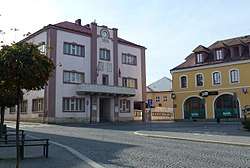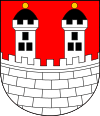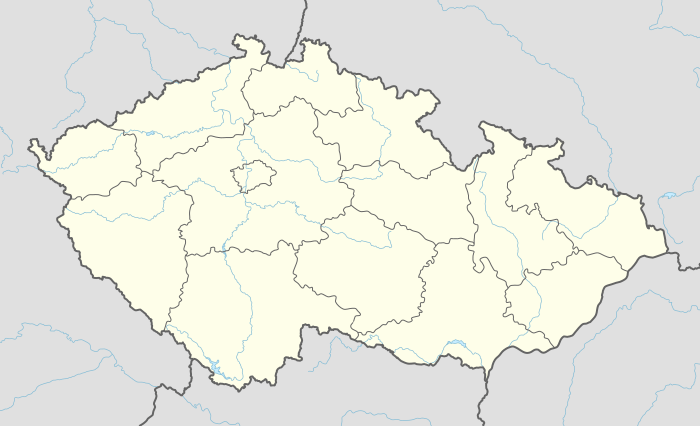Skuteč
Skuteč (Czech pronunciation: [ˈskutɛtʃ]; German: Skutsch) is a small town and is located in the district Chrudim in the Pardubice Region in the Czech Republic.
Skuteč | |
|---|---|
Town | |
 Town Hall in Skuteč on the Palacký Square | |
 Flag  Coat of arms | |
 Skuteč Location in the Czech Republic | |
| Coordinates: 49°50′47″N 15°59′45″E | |
| Country | Czech Republic |
| Region | Pardubice |
| District | Chrudim |
| First mentioned | 1282 |
| Government | |
| • Mayor | Pavel Bezděk |
| Area | |
| • Total | 35.4 km2 (13.7 sq mi) |
| Elevation | 410 m (1,350 ft) |
| Population (2019-01-01)[1] | |
| • Total | 5,046 |
| • Density | 140/km2 (370/sq mi) |
| Time zone | UTC+1 (CET) |
| • Summer (DST) | UTC+2 (CEST) |
| Postal code | 539 73 |
| Website | www.skutec.cz |
The town lies on the cadastral area of 3,540.4 hectares and consists eleven parts: Skuteč (residential locality Skuteč and Přibylov), Hněvětice (residential locality Borek and Hněvětice), Lažany u Skutče, Lešany, Lhota u Skutče, Nová Ves u Skutče, Radčice u Skutče, Skutíčko, Štěpánov u Skutče, Zbožnov and Žďárec u Skutče (localities Žďárec and Žďárec u nádraží).
Geography
The town lies in the undulating and hilly landscape and gave it its name – "Skutečská Upland" (geomorphological unit). It is part of the Iron Mountains. A part of the cadastral territory of the town is a part of the nature reserve "Anenské valley". In the valley flows "Anenský brook" and in the middle of the valley is the Chapel of St. Anne. Landscape area is a part of the National Geopark Iron Mountain.
History
Status of town according to historical sources already won probably around 1330 during the reign of King John of Luxembourg (1310–1346). The first written mention is from 1289, is about the village Skuteč (in the document called Zkuts) and is mentioned in the contract about castles and towns concluded between the Czech King Wenceslas II. and the Earl Friedrich from Meissen. The Charter was found in Dresden (a city in Germany today). The document discovered by Czech historian August Sedláček and published it in 1882 (the work "Castles, palaces and fortresses of the Czech Kingdom"). There is a memorial desk reminding lessons of T. G. Masaryk in a Heyduk street no. 436 in 15-th August 1906. Several Skuteč legionars met him during the war in 1917 to 1918 in Russia.[2]
Population
As of 1 January 2019, a total of 5,046 people was living in the town, with an average age of 43.6 years.[1]
Economy
20th century in Skuteč was significantly associated with shoemaking tradition Botana, companies producing shoes since 1963 by an internationally known brand Botas. Skuteč is known for mining granite and stone industry.
The town today
Municipal Authority in Skuteč manages the town. The administrative building is located on Palacký Square, which is a natural centre of the town. The town has two elementary schools (Primary school at Komenský Square and Primary school at Smetana street) and art school of Vitězslav Novák. In Skuteč town is significant High School – Gymnasium of the Sovereign Maltese Knights order.
Each year the town organizes the festival of classical music and of choir singing "Musical of Skuteč Tomášek and Novák". In the town is town museum, library and cultural center. Significant is Rubeš choir, brass band, Children's Choir Cantando.
Notable people
- Jaromír Funke, Czech photographer
- Václav Tomášek, Czech composer
- Jiří Zástěra, Czech footballer
References
- "Population of municipalities of the Czech republic". Czech Statistical Office. Retrieved 30 April 2019.
- Preclík, Vratislav. Masaryk a legie (Masaryk and legions), váz. kniha, 219 pages, vydalo nakladatelství Paris Karviná, Žižkova 2379 (734 01 Karvina, Czechia) ve spolupráci s Masarykovým demokratickým hnutím (Masaryk Democratic Movement, Prague), 2019, ISBN 978-80-87173-47-3, pages 12 - 70, 101-102, 124–125, 128, 129, 132, 140–148, 184–190.